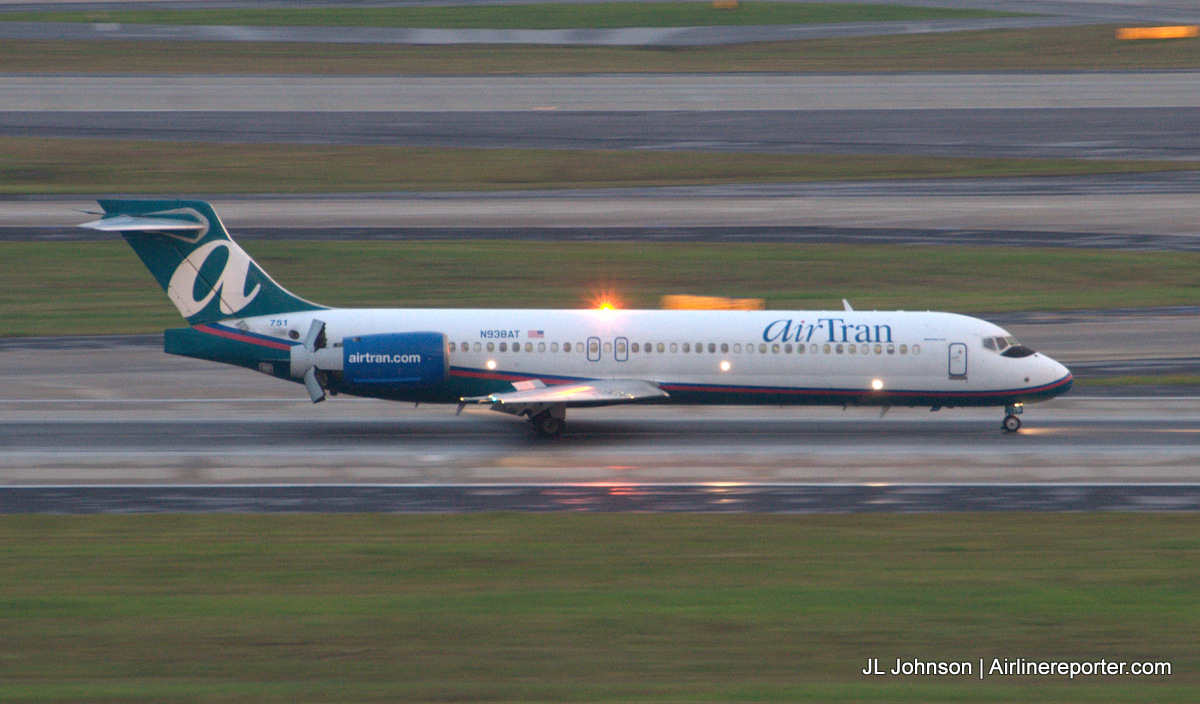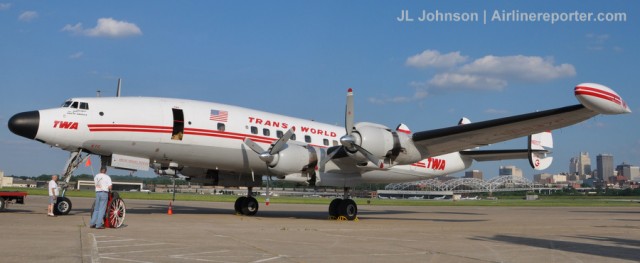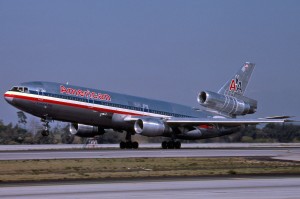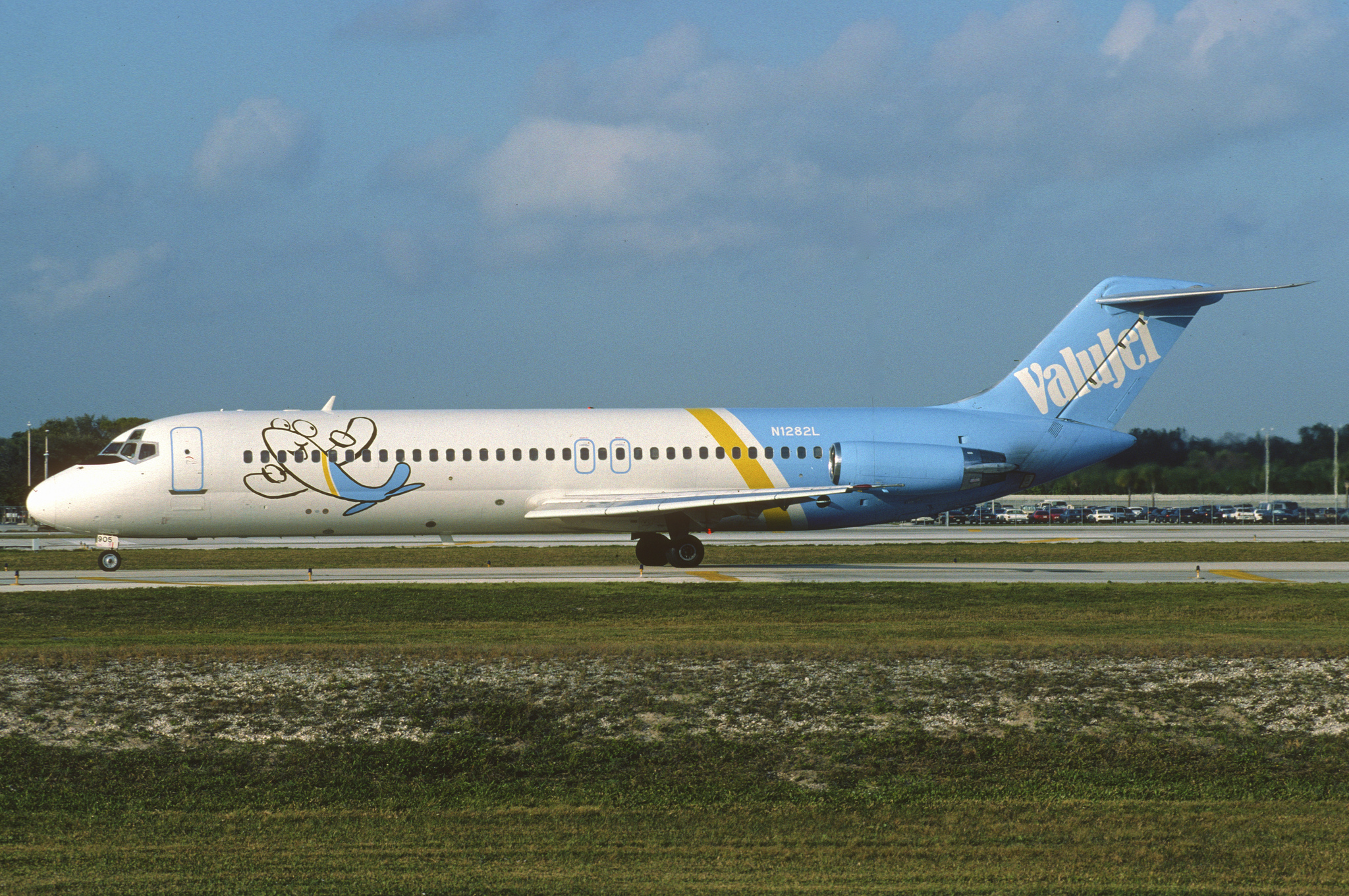
An AirTran Boeing 717 lands in Atlanta
On December 28, 2014, AirTran flight 1 departed Atlanta for Tampa, retracing the airline’s first flight and bringing an end to its remarkable history. I had the honor of being on that last flight and I am excited to share my story. But before I discuss the end of “the big little a” I’d like to first revisit the airline’s history. Because only through knowledge of the airline’s legacy can we truly understand the significance of AirTran’s retirement and integration into Southwest Airlines. So sit back, relax, and enjoy.
ValuJet: Fun and friendly’¦ And perhaps a bit dangerous.
AirTran traces its roots back to ValuJet, an Atlanta-based upstart with dreams of chipping away at Delta’s dominance right in its own backyard. Operations commenced with just a single DC-9, and its first flight was from Atlanta to Tampa on October 26, 1993. In just over a year the airline was solidly profitable and its route map had grown to 17 cities. But fast growth and aggressive cost-cutting practices quickly caught up to the Critter (ValuJet’s FAA call sign.) In the first few years of operation, the small airline had a markedly-high percentage of emergency landings, compared to its peers. In addition, an FAA study indicated that ValuJet dominated the accident data for low-cost carriers.
On May 11, 1996, ValuJet flight 592 went down en-route from Miami to Atlanta; all 110 on board were lost. This tragic, high-profile accident would focus attention on the airline, its maintenance practices, and ultimately lead to its grounding. After a month of investigations by the FAA, which reveled “serious deficiencies in its operation” ValuJet would voluntarily halt operations. But this wasn’t the end for the fledgling airline that had lost its way. Instead, it was just the beginning.

The Star of America, seen at the Kansas City Downtown Airport preparing for engine runs – Photo: JL Johnson
This is the story of a Connie that no one wanted, a plane that was abandoned and mothballed numerous times throughout its history. While it has had a generally-tragic existence, with just a few bright spots sprinkled in, this is an adventure that continues to unfold. In fact, in 2014, this plane will begin a new chapter as it again returns to the skies.
In 1958, this Lockheed Constellation rolled off the assembly line in Burbank, California – destined straight for storage. It was the beginning of the jet age and suddenly airlines had little interest in these sleek, evolutionary, once record-setting birds. Indeed, even those like this 1049H model, which were built with the intent of easy conversion between freighter and passenger configurations, were a hard sell. The variant was canceled after just over 50 were built, this example being third from last. Prior to completion, the order for this plane was canceled, just the beginning of a tough existence for this elegant flying machine.
In September of 1959 after over a year in storage, it was converted to freighter, sold to Slick Airways, and assigned registration number N6937C (which it has carried ever since). For eleven years the plane ran freight with various carriers before being stored and later abandoned in Miami, FL. In June of 1971, it was seized by the airport for non-payment of fees. After being auctioned off it spent the next four years doing odd jobs, hauling military parts and even horses. Its last commercial use was as a sprayer in Mesa, Arizona, where it was equipped with chemical tanks and large spray booms.

American Airlines DC-10 taking off.
This blog is guest written by my father, who was a Naval aviator for twenty years and got me started on my passion for aviation. During a recent chat he shared this story with me and I asked him to write it up as it is a piece of airline history. Here is his story on a trip to New York’s JFK airport:
The year was 1977. I was a young Lieutenant in the United States Navy, stationed at Whidbey Island in Washington. One of the requirements of my job was to represent the EA-6B Model Manager at a NATOPS review conference held at Bethpage, NY. Accompanying me was the other half of the NATOPS Model Manager team, Gary.
We departed out of Seattle, WA for an uneventful trip to New York on an American Airlines DC-10. The airline had a new promotional program called ’œthe bottomless wine glass’. The bottomless wine glass meant there was an unlimited amount of free wine available for the duration of the trip. On the trip to New York we were very responsible drinkers. Our return trip was to be a horse of another color.
The return trip was also on an American Airlines DC-10, however, during this portion of our trip we took full advantage of their bottomless wine glass program. We didn’t have to drive when we arrived back home, so why not? We were seated in the center section, second row back from the bulkhead close to the movie screen. We were also on the aisle, hence easy access to the passing flight attendant.
The flight was seemingly uneventful with us consuming copious amounts of wine until the start of the in-flight movie. Neither of us opted for a headset as that would have cost a few dollars and we were too busy talking about solving ’œthe world problems’ anyway.
The movie started and Gary said that he had recently seen it and from that point on gave a running dialog on the movie since I hadn’t seen it. I’m sure all those around us were totally put out, but, no one said a thing to us.
We continued to drink all the way back to Seattle. In those days there was no such thing as being too intoxicated on a plane; or so it seemed. After landing, I quickly exited the plane thinking Gary was right behind me. I waited at the top of the ramp for what seemed an eternity. Finally, I saw Gary being helped by two flight attendants up the ramp. They brought him over to me a relayed the following events.
Upon exiting the aircraft Gary waited at the aircraft exit door for me to deplane. After everyone had departed the aircraft they closed the door and proceeded to coach Gary up the ramp toward the terminal. Gary then ’œbroke’ free and went back to the aircraft door and started banging on the door and calling out for me. He emphatically told the attendants I was still inside. He was so adamant about me still being onboard they opened the aircraft door and escorted him inside to a totally dark cabin. Still insistent and sounding threatening, Gary made them do a walk through the plane with him.
Flashlights in hand they scoured the entire aircraft. Satisfied I was no longer onboard he quietly deplaned and came up to the terminal where he found me.
Looking back on the inconsideration we showed those around us, I am ashamed. I am not particularly proud of that story but it did happen in an era were heavy drinking was acceptable and Viet Nam was a recent memory so people were more tolerant of military personnel. My how things have changed since then, probably for the better.
Image: 64N31W



